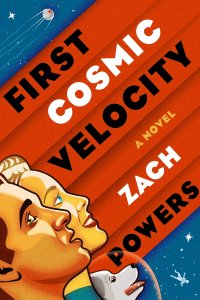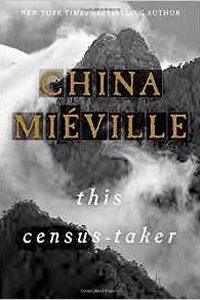Paul Di Filippo Reviews First Cosmic Velocity by Zach Powers
 First Cosmic Velocity, Zach Powers (Putnam 978-0525539278, $26, 352pp, hardcover) August 2019
First Cosmic Velocity, Zach Powers (Putnam 978-0525539278, $26, 352pp, hardcover) August 2019
Thirty years after the fall of the Soviet Union (counting from the initial revolts of the satellite nations in 1989, albeit not from the official dissolution date of 1991)—and ignoring all the present complicated realities that remnant Russia entails on the geopolitical scene—the era of the Communist empire (roughly starting in 1917) seems—at least to my perceptions, and, I suspect, to the sensibilities of others as well—more and more like some fairytale, full of nostalgic quirks and oddities and exoticism. The USSR as combination of theme park and legend. It’s a natural historical process, this softening of the legacy. As the grim specters of gulags, famines, consumer-goods shortages, tight apartments, and H-bomb belligerence fade, what remains are the more quotidian aspects: the daily life, half communally pleasurable, half annoying. Also, the mythic elements: noble heroes and pioneer youths, idealistic dreams and impossible goals.
There’s some of this attitude and approach in Zach Powers’s low-key yet stirring, black-humored debut novel, First Cosmic Velocity, which is an alternate history of the earliest days of the Soviet space program. One crucial year in particular, 1964. And although Powers does not minimize the canonical looking-over-one’s-shoulder paranoia or the brutal power hierarchies, the dominant effect of the book is intimate and personal and fabulaic.
Surprisingly, given the richness of such material, few anglophone authors have ventured into these precincts before. One can cite John Calvin Batchelor’s Peter Nevsky and the True Story of the Russian Moon Landing, and Adam Roberts’s Yellow Blue Tibia. In a skewed way, Byrne and Newman’s Back in the USSA also figures into the equation, as does the graphic novel Laika by Nick Abadzis, although the latter hews pretty faithfully to reality. Fantasies set in Russia are more popular, of course. But the reading list is small.
Powers delivers a valuable addition to the rollcall. His book has a lot of gravitas, mixed with a Catch-22 vibe at times. And although there’s not a lot of ancillary speculation outside the central novum, the narrative offers plenty of cognitive estrangement.
Here’s the hook. The Soviets cannot bring their cosmonaut-piloted capsules down from orbit safely. They burn up all the time, due to defective heat shields. Not willing to admit this, they employ only twins as spacegoers. One goes up and dies in secret, the other then emerges safely from a faked landing to public acclaim. They’ve done this five times now, with no discovery. But things are getting shaky. The surviving twins are a mess, there are no further sets of sacrificial candidates in the lineup, and Khrushchev is demanding bigger and showier missions. What’s the Chief Designer to do?
The story rests on his shoulders and perspectives, but also, alternately, on those of two cosmonauts, Leonid and Nadya. Trotted out for public occasions—under the guidance of their cynical yet mischievous and capricious handler, a woman named Ignatius—they are festering in guilt and uselessness. About the only joyous element in their Star City lives is the dog Kasha. And when Kasha is threatened with destruction, the two survivors reach a breaking point in their loyalties and silence. Perhaps only an interview with Konstantin Tsiolkovski himself—”Maybe a man, maybe a saint, maybe a god, maybe all three.”—can break the logjam. (Tsiolkovski’s role as an eccentric SF writer offers some mordant Kilgore Trout analogies.)
Powers’s plot—occupying just a portion of 1964, with large flashbacks to Leonid’s youth in the small village of Bohdan during the 1950s—is low key and subtle and slow-moving, save for a couple of vivid and tense moments of crisis, both involving technological disasters. Basically he intends to steep the reader in the day-to-day experience of his finely drawn cast as they labor to reach the stars by duplicity. The contrast between noble aspirations and utilitarian methods is at the core of the book, and each character has to juggle their own personal bookkeeping of virtue and sin. I haven’t even mentioned many of the colorful minor players, such as gung-ho cosmonaut Grigori; the General Designer, rival to our Chief; and the two assistants Mishin and Bushuyev whom no one can tell apart. They all receive loving depictions from Powers’s deft hands.
Overall, the tale is a Kafkaesque parable of the seductive power of lies in the service of bold and worthy aspirations. And dare I mention a certain Malzbergian aura, especially in the motif of Leonid’s orbiting twin, who should have died after five days, but continues impossibly to broadcast for weeks afterwards, a voice of despairing wisdom. This riff also recalls Dick’s “orbiting disc jockey” Walt Dangerfield in Dr. Bloodmoney, a book actually written during Powers’s chosen era, and representative of the same ethos and zeitgeist.
One of the important subtexts of the novel is that of identity. The melding of twins into one hypothetical individual is the most obvious example of this motif, but the theme is omnipresent, as even the Chief Designer has to deal with an obliterated past. And when the cosmonauts are labeled heroes, it’s just another filter. Here’s the irrepressible Ignatius on the topic.
“Nobody knows Nadya. They just know her face. Her accomplishments. Part of being famous is being anonymous. A hero isn’t a person but an act. An ideal to worship. That’s what it is. Worship. In a nation without a god, we must provide an outlet for faith. We must show the people that greater heights exist, not on some ethereal plane, but right here on Earth. Or, in Nadya’s case or yours, in outer space.”
“So we’re just symbols, not people?”
“Of course you’re people. Just not the people that everyone thinks you are.”
In addition to its meticulous and ingenious blueprinting of a past that never was, First Cosmic Velocity is the story of breaking through the veils of identity that stiflingly enwrap us and blinker us, in public and private, and seeing the stars for the very first time.
 While you are here, please take a moment to support Locus with a one-time or recurring donation. We rely on reader donations to keep the magazine and site going, and would like to keep the site paywall free, but WE NEED YOUR FINANCIAL SUPPORT to continue quality coverage of the science fiction and fantasy field.
While you are here, please take a moment to support Locus with a one-time or recurring donation. We rely on reader donations to keep the magazine and site going, and would like to keep the site paywall free, but WE NEED YOUR FINANCIAL SUPPORT to continue quality coverage of the science fiction and fantasy field.









Very interesting, thanks for pointing at this novel!
I would add to the “see also” list the novel Red Moon, by David S. Michaels – because of the theme/setting/topic – and The Separation, by Christopher Priest – because of the twins parallel.